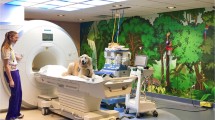Abstract
Sedation and anesthesia for pediatric imaging departments has changed dramatically for the following reasons: (1) radiologists have stopped sedating patients; (2) the majority of sedations are not for CT (because of the speed of the procedure) but for MR, which lasts 45 min or greater; (3) a cadre of services—pediatricians, emergency medicine physicians, hospitalists and intensivists, as well as anesthesiologists—can provide the services. These changes have significantly influenced the type of agents utilized for sedation and anesthesia and, most important, have created operational issues for MR departments. Nevertheless, it is important for each imaging department to create a uniform approach to sedation, taking into account patient expectations, efficiency of through-put, facilities and personnel available, and institutional costs.



Similar content being viewed by others
References
Townsend BA, Callahan MJ, Zurakowski D et al (2010) Has pediatric CT at children’s hospitals reached its peak? AJR 194:1194–1196
American Society of Anesthesiologists (2011) ASA Physical Status Classification System. Available via http://www.asahq.org/clinical/physicalstatus.htm. Accessed 28 Jan 2011
Hansen-Flaschen J, Cowen J, Polomano RC (1994) Beyond the Ramsay scale: need for a validated measure of sedating drug efficacy in the intensive care unit. Crit Care Med 22:732–733
Koch BL (2008) Avoiding sedation in pediatric radiology. Pediatr Radiol 38(Suppl 2):S225–S226
Khan JJ, Donnelly LF, Koch BL et al (2007) A program to decrease the need for pediatric sedation for CT and MRI. Appl Radiol 4:30–33
Starkey E, Sammons HM (2010) Sedation for radiological imaging. Arch Dis Child Educ Pract Ed [Epub ahead of print] July 30 doi:10.1136/adc.2008.153072
Mason KP, Michna E, DiNardo JA et al (2002) Evolution of a protocol for ketamine-induced sedation as an alternative to general anesthesia for interventional radiologic procedures in pediatric patients. Radiology 225:457–465
Mason KP, Zgleszewski SE, Prescilla R et al (2008) Hemodynamic effects of dexmedetomidine sedation for CT imaging studies. Pediatric Anesth 18:393–402
Mason KP, Zurakowski D, Zgleszewski SE et al (2008) High dose dexmedetomidine as the sole sedative for pediatric MRI. Pediatric Anesth 18:403–411
Siddappa R, Riggins J, Kariyanna S et al (2011) High-dose dexmedetomidine sedation for pediatric MRI. Pediatric Anesth 21:153–158
Koroglu A, Teksan H, Sagir O et al (2006) A comparison of the sedative, hemodynamic, and respiratory effects of dexmedetomidine and propofol in children undergoing magnetic resonance imaging. Anesth Analg 103:63–67
Zgleszewski SE, Zurakowski D, Fontaine PJ et al (2008) Is propofol a safe alternative to pentobarbital for sedation during pediatric diagnostic CT? Radiology 247:528–534
Vanderby SA, Babyn PS, Carter MW et al (2010) Effect of anesthesia and sedation on pediatric MR imaging patient flow. Radiology 256:229–237
Disclaimer
The supplement this article is part of is not sponsored by the industry. Dr. Slovis has no financial interest, investigational or offlabel uses to disclose.
Author information
Authors and Affiliations
Corresponding author
Rights and permissions
About this article
Cite this article
Slovis, T.L. Sedation and anesthesia issues in pediatric imaging. Pediatr Radiol 41 (Suppl 2), 514 (2011). https://doi.org/10.1007/s00247-011-2115-2
Received:
Revised:
Accepted:
Published:
DOI: https://doi.org/10.1007/s00247-011-2115-2




